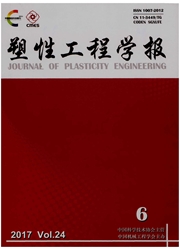

 中文摘要:
中文摘要:
板料成形反向模拟法中接触状态判断的准确与否直接影响到计算的精度及迭代收敛的速度。文章提出了两种判断模具与板料接触状态的策略,即基于单元节点拓扑关系的几何判定法和基于单元节点内力的物理判定法。几何判定法只需要工件的网格信息,提出了一种简单的获取节点拓扑关系的算法,可以快速地获取凸凹模与板料的接触状态。物理判定法根据单元节点力的平衡方程,由内力计算公式直接判断接触状态。通过分析比较,几何判定法对于浅拉深件,具有较好的适用性;而物理判定法对于几何判定法无法准确处理的平面特征较多或是网格质量较差的情况,却保持着良好的适用性及较高的计算效率。
 英文摘要:
英文摘要:
The ability of treating contact condition precisely has a great influence on precision and convergence speed in reverse analysis method of sheet metal stamping. Two contact treatment strategies are proposed to use in inverse analysis method: geometric strategy based on topological relations of nodes and physical strategy based on nodal internal forces. An easy-to-use algorithrn is proposed to find the topology of concerned nodes. The geometric strategy relies only on the discretized workpiece with triangular meshes. So it is very fast to obtain the contact state While the physical strategy is based on equilibrium equation of related nodes. The internal force is used directly to judge the contact state. A rectangular box drawing example shows that geometric strategy is easy to use for shallow drawn parts, while the physical strategy is very robust and efficient even with plane-dominated features, distorted meshes which geometric strategy can not deal with efficiently.
 同期刊论文项目
同期刊论文项目
 同项目期刊论文
同项目期刊论文
 Mechanism of localized severe plastic deformation and damage fracture in fine-blanking using mixed d
Mechanism of localized severe plastic deformation and damage fracture in fine-blanking using mixed d 期刊信息
期刊信息
